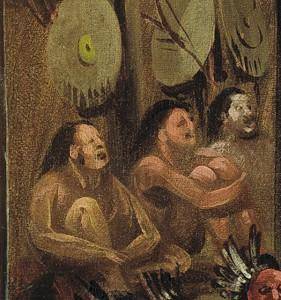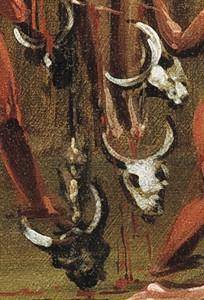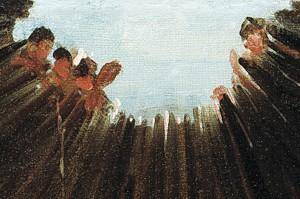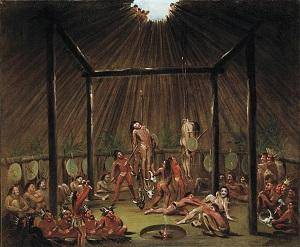The Cutting Scene, Mandan O-kee-pa Ceremony
- George Catlin, American, 1796-1872
- Born: Pennsylvania
George Catlin [CAT-lin] was born in Pennsylvania in 1796. At age 33, he had a new wife and a promising career as a portrait painter, but he was still searching for a way to leave his mark on the world. Like most people at the time, Catlin believed American Indian cultures were doomed. He decided to abandon his career, journey west, and devote his life to documenting these “vanishing races.” Over the next six years, Catlin visited 48 tribes and, though he had very little formal training, created hundreds upon hundreds of paintings. After his last trip west, Catlin focused on promoting his “Indian Gallery.” This exhibition featured hundreds of paintings and artifacts, a tipi, models posing in American Indian dress, and sometimes even reenactments of dances, ceremonies, and battle scenes.
While some believe that Catlin’s work exploits American Indian cultures, others see his paintings as important records of the history of various tribes. “Future generations are going to need [Catlin’s paintings and writings] because nobody tells the stories anymore . . . Whether it’s fortunate or unfortunate, [Catlin’s stories] are gonna be there, because they’re written down,” says Lyle Gwin (Mandan/Hidatsa). Regardless of interpretation, George Catlin is remembered for dedicating his life to making a pictorial record of American Indian cultures.
The Cutting Scene is part of a series of four paintings by Catlin that depict the O-kee-pa ceremony, the central religious activity of the Mandan Indians. The young men in this painting were willing participants in this sacred ceremony, which was held to ensure the community’s prosperity. During the part of the ritual depicted in this painting, wooden splints were inserted into the participant’s chest and back muscles (a procedure that, although painful, didn’t cause lasting injury). The participants were then suspended by cords that were lowered down from the top of the lodge and attached to the splints. According to Calvin Grinnell, Cultural Preservation Specialist for the Mandan, Hidatsa, and Arikara Nation, “this is a trance-like state, they would be faint, and that’s when we believe the messages come.” These men would have considered it a great honor to take part in the O-kee-pa ceremony, at the end of which they were recognized as warriors of courage and fortitude.
By sheer chance, Catlin arrived in a Mandan village a week before their O-kee-pa ceremony began. Over the course of this week, he won the community’s respect and admiration by painting their portraits. Catlin returned the community’s sentiment and stated, “A better, more honest, hospitable and kind people, as a community, are not to be found in the world.” When the ceremony began, a holy man invited Catlin to witness the events taking place inside the sacred lodge. Catlin was one of the few non-Indians to witness this ceremony, which was outlawed in 1890.
Details

Sketch-like Painting
Catlin’s painting looks sketchy and to some, unfinished. DAM art historian and Catlin scholar Joan Carpenter Troccoli says, “He left things in a sketchy state because that is the most truthful moment in the history of a picture, when an artist is right in front of his subjects.” Catlin was working hard to document as many different tribes as possible. Always in a rush, he painted swiftly, in thin layers of paint that would dry quickly.

Elders
In the bottom right corner of this scene, male elders, chiefs, and medicine men sit and observe the event. According to Grinnell, they “were taking a measure of [the young men’s] character and their fortitude and their willingness to sacrifice for the common good.”

Waiting Participants
In the bottom left corner, participants prepare for the ceremony by feasting and staying awake for four days. Grinnell explains, “It’s a means of focusing the mind on your prayers, on your communication with the Great Spirit and the lesser spirits.”

Piercing
Just to the right of the fire, two men put splints into the arms, legs, and chest of a participant. The participant probably painted his body with white clay. Catlin noted that all participants painted themselves red, yellow, or white.

Bison Skulls
Grinnell points out that bison skulls have been hung from one participant’s legs “to add weight to his suffering.”

Men Looking In
The men sitting on top of the lodge lower down cords that are attached to the splints in the participant’s arms, legs, and chest.

Circular Lodge
The Mandan lived in circular earth lodges similar in design to the circular lodge seen in The Cutting Scene.
More Resources
Websites
Smithsonian American Art Museum’s Catlin Classroom
An interactive site that uses George Catlin’s art and writings as departure points for discussing Native American life. Includes a teacher guide.
Museum of the American West
A web resource with accounts of Catlin’s life, experiences, influences, and artworks.
Handouts
Catlin Cubes Handout
This handout contains text and images from the Catlin Cubes interactive at the Denver Art Museum. These cubes present multiple historical and contemporary perspectives on Catlin’s painting. The last page is a template for creating the cubes.
Books
Catlin, George. George Catlin and His North American Indian Gallery. New York: Norton, W. W. & Company, Inc., 2002.
A text accompanying the foremost collection of the artist’s works.
Catlin, George. Letters and Notes on the Manners, Customs, and Conditions of the North American Indians. London, 1841, reprint: Dover Publications, New York, 1973.
A two volume set of Catlin’s writings and opinions of the North American Indians he encountered. See letter No. 22, Vol. 1, pages 175-208.
Children's Books
Catlin, George and M. G. Humphreys, ed. The Young Reader’s Catlin: My Life Among the Indians. Scituate, MA: Digital Scanning, Inc., 2001.
Includes a biographical sketch and images of his paintings. For ages 9-12.
Plain, Nancy. The Man Who Painted Indians: George Catlin. New York: Benchmark Books, 1997.
A biography of Catlin, for ages 9-12.
Reich, Suzanna. Painting the Wild Frontier: The Art and Adventures of George Catlin. New York City: Clarion Books, 2008.
For ages 9-12, a biography of George Catlin that includes photographs, many of his paintings, and excerpts from his letters and notes.
Funding for object education resources provided by a grant from the Morgridge Family Foundation. Additional funding provided by the William Randolph Hearst Endowment for Education Programs, and Xcel Energy Foundation. We thank our colleagues at the University of Denver Morgridge College of Education.
The images on this page are intended for classroom use only and may not be reproduced for other reasons without the permission of the Denver Art Museum. This object may not currently be on display at the museum.
